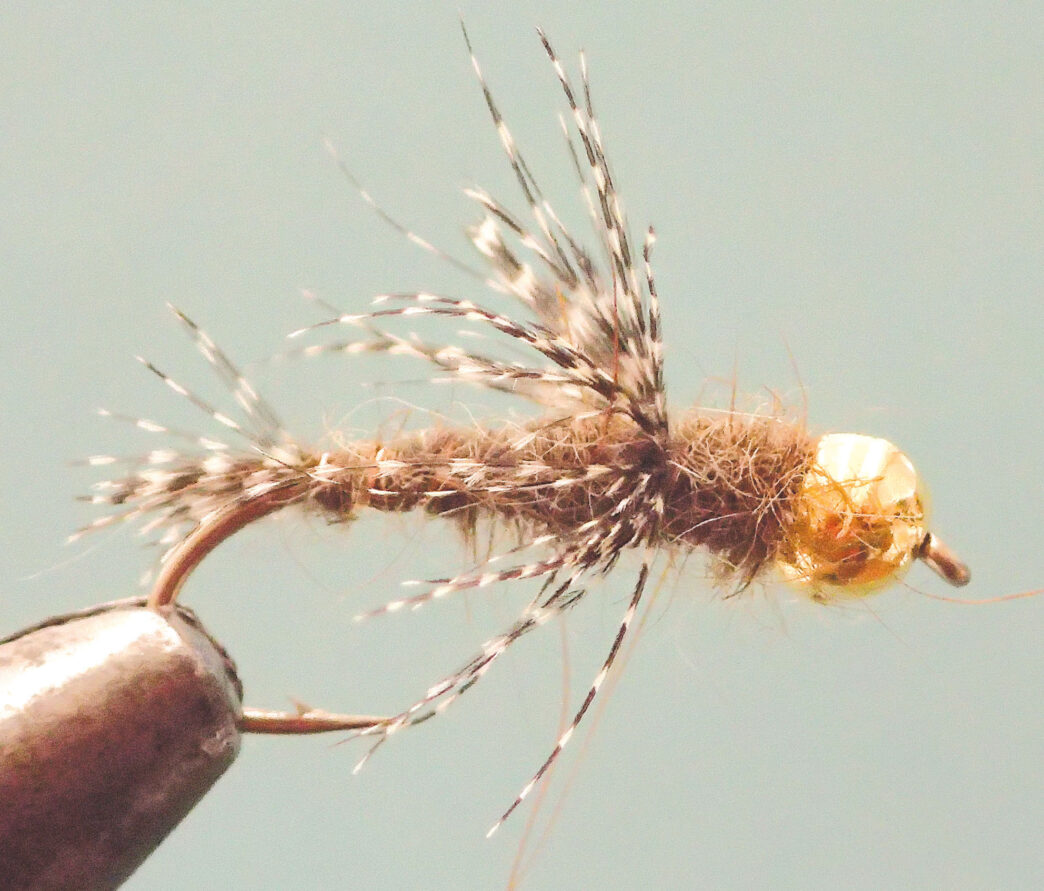Anyone who has ever learned to spin fur and feathers on a hook has experienced the nearly irresistible urge to tweak somebody else’s successful fly pattern. Cal Bird’s famous nymph, the Bird’s Nest, is so versatile that most anglers I know carry a large supply, and few patterns have inspired so many variations on the original theme.
I won’t endear myself to commercial fly designers by admitting this, but close to 90 percent of my trout fishing is done with a single fly, a size 12 brown Bird’s Nest Nymph. A long time ago, folks I fish with a lot quit asking me, “Hey, what fly you using?” If they forget and get the words out before catching themselves, I often hear a predictable sigh, then, “Oh yeah . . . ” and we both end up mouthing the words together, “a Bird’s Nest,” like a well-rehearsed duet.
The reason I do this isn’t because of laziness or lack of imagination. It’s because I’ve had so much success with this pattern in so many places that there seldom seems a good reason to use anything else. In other words, my confidence in this pattern is rock solid. I tie this fly only in size 12, because there seems no need to tie it in different sizes. When it makes sense to fish smaller nymphs (on spring creeks mainly), I tie on a different pattern.
I’ve caught rainbow trout, browns, brookies, Yellowstone cutthroats, west slope cutts, lake trout, Dolly Vardens, and steelhead on it, There’ve been largemouth, smallmouth, and Alabama spotted bass, arctic grayling, whitefish, pikeminnows, and suckers (not intentionally). Bluegills and crappies impale themselves upon it. I use it on both streams and lakes, especially if the lake has a population of Callibaetis mayflies. Perhaps the real trick is in knowing when it’s best not to use it — the other 10 percent of my fishing. When there is an opportunity to fish dry flies, of course I do so. But the Bird’s Nest has become my go-to solution for what amounts to “normal” fishing conditions in a lot of places around California: no fish rising and few bugs in the air.
Before I get in over my waders on this, I’ve come to believe that the specific nymph pattern you use is less important than how you fish it. What matters most in nymph fishing in moving water is that you get a natural dead drift and are ultrasensitive in setting the hook. Mastering these two skills will take you a long way in nymph fishing, no matter what fly you’re using. That said, there are fly patterns (such as the Bird’s Nest) that are proven winners in a great variety of situations. Adding a killer fly to a foundation of superior nymphing skills is an undeniable formula for success.
Cal Bird’s Disciples
I never got a chance to meet Cal Bird before he passed away, but I’ve known Tom Peppas, one of Cal’s understudies, for many years. My interest in the Bird’s Nest led me to Tom, who then led me to another Cal Bird confederate, Keith Barton. You can learn more about Cal Bird (and many other things) at Barton’s Web page, Singlebarbed: Fishing the Unloved and Pedestrian, http://singlebarbed.com.
“I was fortunate to have spent many hours tying with Cal in San Francisco,” Barton told me. “I used to man one of the fly shops there, and Cal had a great fondness for the local wreath cake on Sunday morning . . . that and his wife shushed him out of the house due to incessant cigar smoking.
“Cal Bird was a calligrapher by trade — and a trained artist. His knowledge of primary and secondary colors (of the artist’s color wheel) is what seeped into much of his tying, because he was a generalist tyer, and not an imitator of insects. He believed in color and material selection to provide motion — or the appearance of motion — in most of his fly patterns. The Bird’s Nest was no different.
“I don’t think Cal knew that I would be his unofficial biographer, despite all the coffee and wreath cake we put down, but he was such a hell of a nice fellow, I’m happy to pass on any information that I have.”
According to Barton, Cal’s original dubbing mixture for the Bird’s Nest was 50 percent gray Australian possum, 40 percent hare’s mask (including guard hairs), and 10 percent natural baby seal fur. The wing and tail were teal flank feathers tinted with RIT “maple sugar” cloth dye, and the abdomen was ribbed with thin copper wire. Almost before the head cement was dry on the original pattern, friends of Cal’s, including Tom Peppas, began adding their own touches. If you had spent any time around Clearwater House on Hat Creek, you would have either met Tom Peppas or felt his influence. He was Clearwater’s very first guide (and second and third, if you ask him), and tyer of the tens of thousands of Bird’s Nest patterns sold through their busy fly shop. Now approaching 70 years of age and not quite ready to retire, Peppas is a walking encyclopedia of Northern California fly-fishing knowledge and lore. However you regard my one-fly Bird’s Nest addiction, whether you consider it high cunning or total ridiculousness, I refer all challengers to my great nymphing mentor, Tom Peppas.
“Cal was a good friend,” recalls Peppas. “He came up with the Bird’s Nest as a caddis emerger, and it was for his fishing on the Truckee River. That’s where it all originated.”
Watching Peppas swim a Bird’s Nest through the pockets, riffles, and runs of the Pit River is like watching a pro golfer on the green. Before you know it, the ball is in the cup, and you’re left wondering what magic, what incantation, you somehow missed in what went on. He makes hooking trout on nymphs look so easy.
“The first Bird’s Nests that came out of Clearwater were my deal,” Peppas explained. “I was taught by Cal Bird, but I thought his fly was a little bulky for the fishing we do in our area, so I made it a little more sparse. That was my take on the Bird’s Nest, and that’s how I fished it forever. It’s been my 90 percent fly all through these years. I tied Bird’s Nests commercially for at least 20 years, anywhere from five to seven thousand a year just for Clearwater.”
When I asked him how quickly he could tie a Bird’s Nest, he responded in classic Tom Peppas style: “Twenty Bird’s Nests an hour, that’s usually with a couple of cups of coffee and a cinnamon roll. I’d get that caffeine and sugar pulsating through my body. In the evening, with Jack [Daniels] on the rocks, eleven or twelve.” Peppas ties the Bird’s Nest in three basic colors, brown, gray, and black, and mixes the dubbing himself.
“I use a 50/50 blend of rabbit fur and Australian possum. Australian possum fur basically comes in two shades, kind of a grayish color and kind of a brown. When I tied the brown Bird’s Nest, it was brown with cinnamon-dyed rabbit fur 50/50. The gray Bird’s Nest was natural rabbit with the gray Australian possum, 50/50. The black Bird’s Nest was just dyed rabbit fur. I’ve tried it in olive and cream colors, but I’ve decided it’s best either dark or light, the latter brown or gray. Black is killer, probably the best one. Every once in awhile, if I want to fish a bead, I’d put it on the brown Bird’s Nest, but mostly I fish it nonbeaded.
“There’re a lot of different things that work. The two feathers I use the most are green-wing teal and wood duck. You can overthink it. It’s really about getting the right shade and the right size fly. It always has been. The fish are not that critical, really. On Hat Creek fishing the mayfly hatches, the bread-and-butter dry fly has always been the pale olive Paradun. You could also fish it in gray, light beige — all those light colors. They would all work the same. It’s because the fish are looking at a shade and don’t see color. On a tough day, fishing any color will be tough. On a really grabby day, any color is going to work pretty well.
“In some of the brown dubbing I would add Antron. I think it gives the fly a little iridescence. Fish see ultraviolet light, and they see shininess. That’s why I think copper wire works on this fly. The reason peacock herl works so well on some flies is because it has that little shine or shimmer to it. It’s the same thing with Antron. When bugs hatch, they have this bubble connected to their body that gives off a little sheen. For the tail and wing on the black version, I just use mallard rump. It’s black, but it also has that green look, like peacock herl.
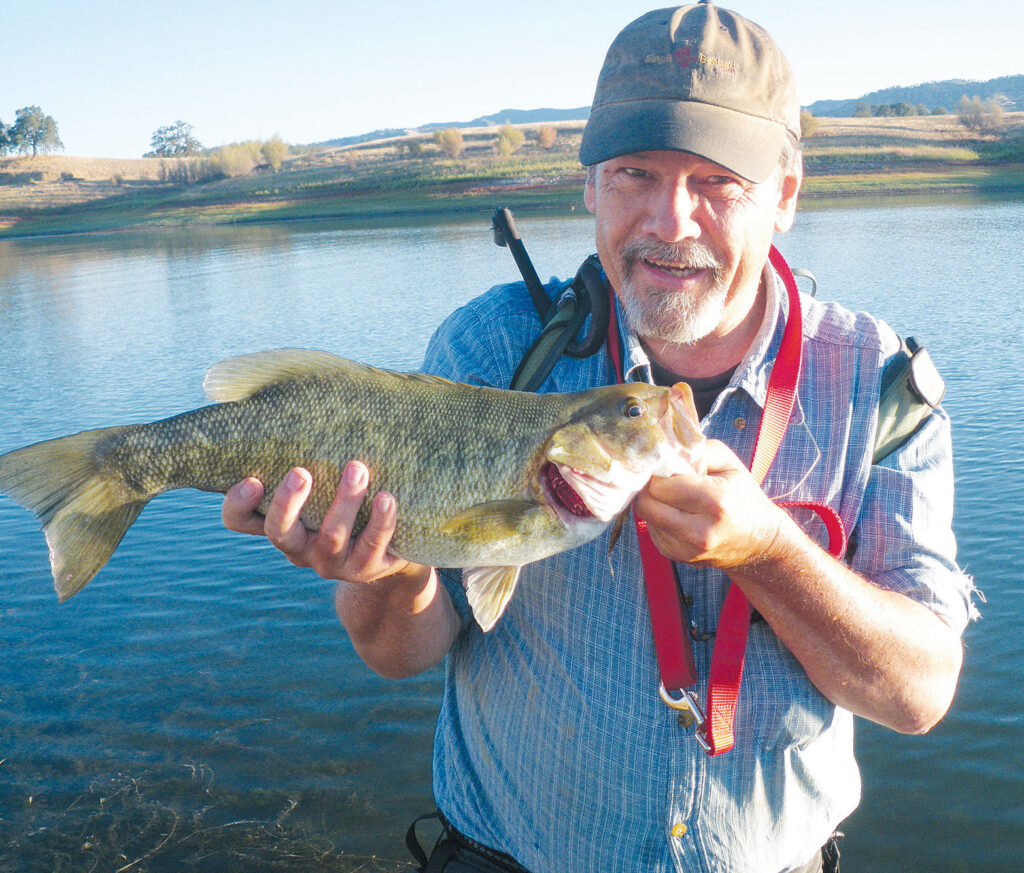
“The shape of the nymph is probably the most important thing, and I think the feathers are secondary. A slim profile always seems to be best. If you’re fishing Montana streams, I’d use bulkier patterns, but out here, smaller patterns fish better in general.
“Clay Green, one of my pupils out of Mill Valley, likes to use a blond Bird’s Nest on the McCloud River, and it fishes really well. It’s kind of a creamy orange-blond color. A lot of different light colors will work. A lot of dark colors will work, if they’re in a size the fish can get excited about. I fish a sparse black size 14 Bird’s Nest for the Isonychia hatch on the Pit River, and it’s killer. It’s not really a mayfly pattern, but the fish take it.
“I use to fish with Cal on the lower stretch of Hat Creek a fair amount,” continued Peppas. “One of my favorite times was during the Salmon Fly hatch. We were sitting there having lunch and Cal was tying. He says, ‘You know, I’m going to tie something up for fishing the Salmon Fly hatch.’ ”
“It was on a long-shank hook. He took hackle and he just wrapped one wrap after another. He took about three feathers to wrap the complete shaft from the bend of the hook to the head. It floated like crazy and it was killer good. He never named it or promoted it, but it was incredibly good.
“Once on the Fall River, Keith Barton, Gary Warren, and I were fishing above CalTrout from the pump down to the bridge. The night before was the third of July, and I’d tied up a bunch of ‘Fourth of July’ Bird’s Nests in red, white, and blue. We swung ’em down through there, and we absolutely clobbered ’em. It basically was a white body with a red tail, a blue collar and a red head. It was killer. I think the profile of the fly really lends itself to success.”
The O’Brien Bird’s Nest
My own version of the Bird’s Nest is not available for sale anywhere, which is how I get away with pasting my name on it. I didn’t invent the fly, but merely tweaked Tom Peppas’s version, so it’s a really variation of a variation. While I’m pretty sure I got the dubbing mixture from Peppas back in the 1990s, I note that it is slightly different than what he typically uses.
I take one package of Hareline chocolate brown dubbing and mix it by hand with all the hairs (gray and brown) from a patch of natural Australian possum fur. I start by putting the packaged dubbing and the fur cut from the hide in a pile on a table. Then, using my fingers, I pull the mass apart and squash it back together for about ten minutes trying to get as even a blend as possible. I would not say my method is sophisticated, but the result is enough usable dubbing to get me through about a year of tying my Bird’s Nests. I tried using a coffee grinder once to mix the dubbing, but the mixture came out in unusable globs. I can afford ten minutes per year to do it right.
Since I prefer the sexy profile of a slightly curved shank hook, I went with a TMC 2302, size 12. The tungsten bead I added was mainly the result of all the stillwater fishing I do, even though I use the fly extensively on rivers, as well. The tungsten bead allows me to eliminate split shot to sink my f lies in lakes, and the fewer things you have on your leader, the fewer things there are to get tangled. Here are the materials I use for tying my O’Brien Bird’s Nest:
Hook: TMC 2302, size 12
Thread: Brown 6/0
Bead: Tungsten to fit hook
Tail/wing: Teal flank
Dubbing: 50/50 mix of natural Australian possum and Hareline chocolate brown dubbing
Rib: Narrow copper wire
My method of attaching the wing seems barbaric compared with Cal Bird’s. Bird used a distribution wrap, in which the tying thread grabs the feather barbules and deploys them around the circumference of the hook shank. Cal had strong feelings about how to do this, and Keith Barton has preserved the method for posterity on his Web site: “His distribution wrap was used because teal f lank (as well as all duck f lank) rarely gives a uniform shaped feather,” Barton explains. “If the feather had one straight side, Cal would clip that section out and then use the distribution wrap to make it wrap around the hook.” However, if the feather was uniform, he would cut out the tip and use it as the tail, then use the remaining chevron of fiber for the distribution wrap. “I see a lot of renditions of Cal’s flies where the technique is not used,” Barton says, “and I think it equally important that we show subsequent generations of tyers how to master a troublesome feather with ease.” (You can find illustrated instructions on Cal’s distribution wrap at http://singlebarbed.com/2009/12/28/cal-birds-modified-distribution-wrap-for-monty-montana.)
Compared with Cal Bird, I am a cheesy hack when it comes to tying flies, and you could hardly call mine a distribution wrap at all. I cut the teal fibers in a glob, hold them on top of the body, and take six or seven wraps to connect them to the fly. Sometimes the wing just sits there on top of the hook. Other times it will swing to the bottom or one of the sides. But sometimes it spreads itself out perfectly, looking almost as good as the original. The reason I don’t care what happens with the wing is that I’ve found the crappy-looking flies fish just as well as the few perfect ones. Bottom line: I tie flies to catch fish, not as an expression of my artistic skill or lack thereof. I honestly don’t mind being a knuckle-dragger at the fly-tying table, as long as when I’m on the water, my rod is bent a good portion of the time.
Fish must see something in Australian possum fur that we cannot, and this was brought home to me one afternoon fishing Hat Creek with Andy Burk. Andy is, of course, a virtuoso fly tyer, and we were fishing the popular stretch of Hat that runs through the town of Cassel, California.
We were standing on the levy, fishing small mayfly nymphs (not Bird’s Nests) under indicators. Our flies were very similar in terms of size, shape, and overall color. Burk was (naturally) catching two fish for every one of mine. Finally he was gracious enough to give me one of his flies, and I was soon matching him fish for fish. I found this amazing. When we talked about it later, it became evident that the main difference between our two nymphs was that my dubbing mixture lacked Australian possum. I would not have believed this was what made the difference in effectiveness under any other circumstances.
The ways I fish the Bird’s Nest in rivers depends on how close I can get to the fish. In some parts of Northern California’s upper Sacramento, Pit, or McCloud Rivers, you can get within a rod’s length of near-perfect pockets around boulders, all holding trout. I begin by fishing the close water on a short line, holding the tip of the rod down close to the surface of the water. What I’m trying to do is drag the nymph downstream on a tight line, watching my red Amnesia butt section for any hesitations or unusual movements. I set the hook first and ask questions later.
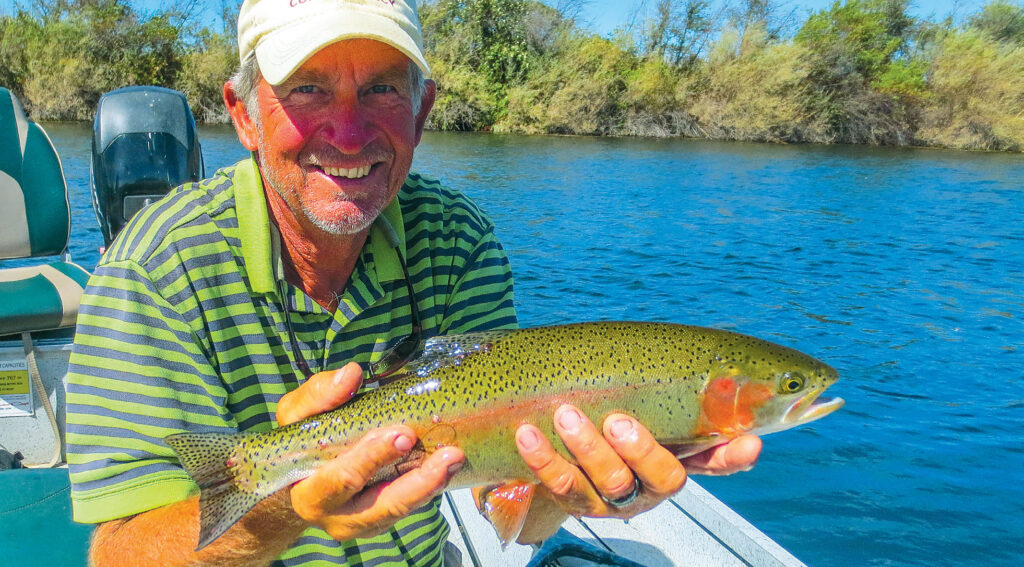
Once the close water has been covered, I put a small Thingamabobber or corky-style indicator four or five feet above my Bird’s Nest and cover the pockets farther out in the stream. I rarely fish dropper flies, since I’m not willing to sacrifice the fishing time I often lose getting tangled or snagged on rocks. I prefer to fish one fly very well, rather than deal with the frustrations of fishing two.
Though it sometimes seems about as exciting as watching paint dry, hanging a Bird’s Nest under a small indicator on lakes can be so effective that you’d be a fool not to do it. This is my go-to technique for fishing Keswick Reservoir, Baum Lake, Lewiston and Manzanita Lakes, as well as many other Northern California still waters. It works especially well during the summer at the height of the Callibaetis hatch. Cal Bird may have been trying to imitate a caddis, but his creation seems to look enough like a mayfly or stonefly to be effective in a multitude of places much of the time.
I do not fish my Bird’s Nest on the flat water of Hat Creek. In fact, I rarely fish nymphs there at all, except in “the riff le” (below Powerhouse 2) and down below the Highway 299 bridge. On Hat’s flat water, it seems as though the fish hide underneath the weed beds most of the time. When there is a hatch (usually one of several species of small mayflies so prolific there), the fish come out, and I blissfully fish dry flies. This approach has worked about as well for me as any other approach to these trout some of the toughest I know.
Credit Where Credit Is Due
“Cal was pretty inflexible about the bug thing,” Peppas says, “and what the Bird’s Nest might look like to the fish. I tied all those flies for Clearwater, and he looked at ’em and noted they were more sparse than his. He wanted me to call ’em something else besides Bird’s Nests.
“ ‘Cal, I can’t do that,’ I said. ‘This is your Bird’s Nest. It may be my version of it, but it is totally your Bird’s Nest, and it would be blasphemous to call it anything else.’ He still wanted me to rename it, but I had to disagree with him. A Bird’s Nest is a Bird’s Nest.”
So perhaps that’s the definitive word on the subject. “A Bird’s Nest is a Bird’s Nest,” and tyers have been tweaking it from the very start. All that’s left is putting your own spin on it.
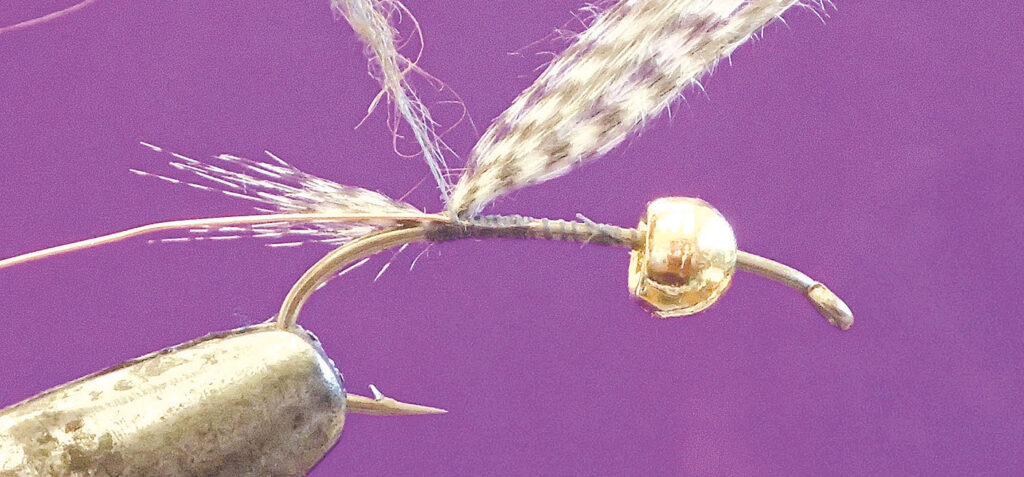
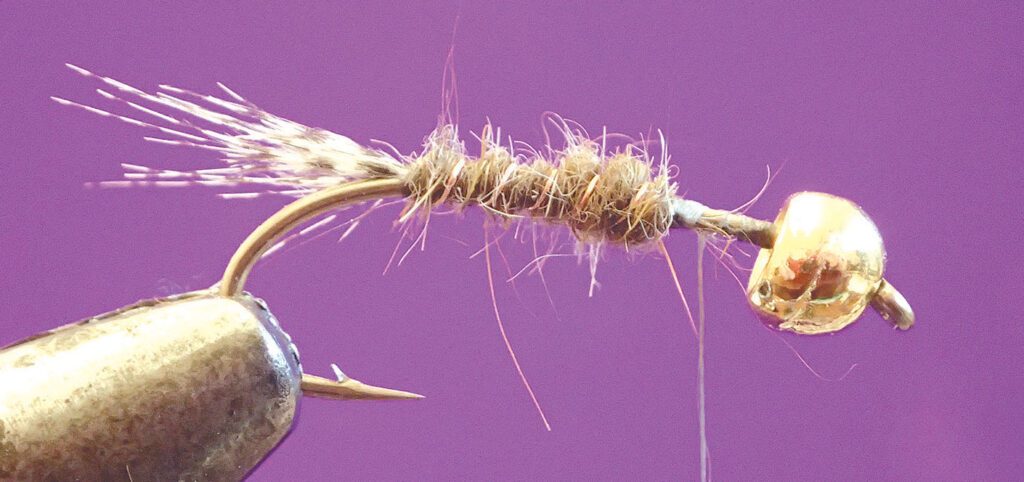
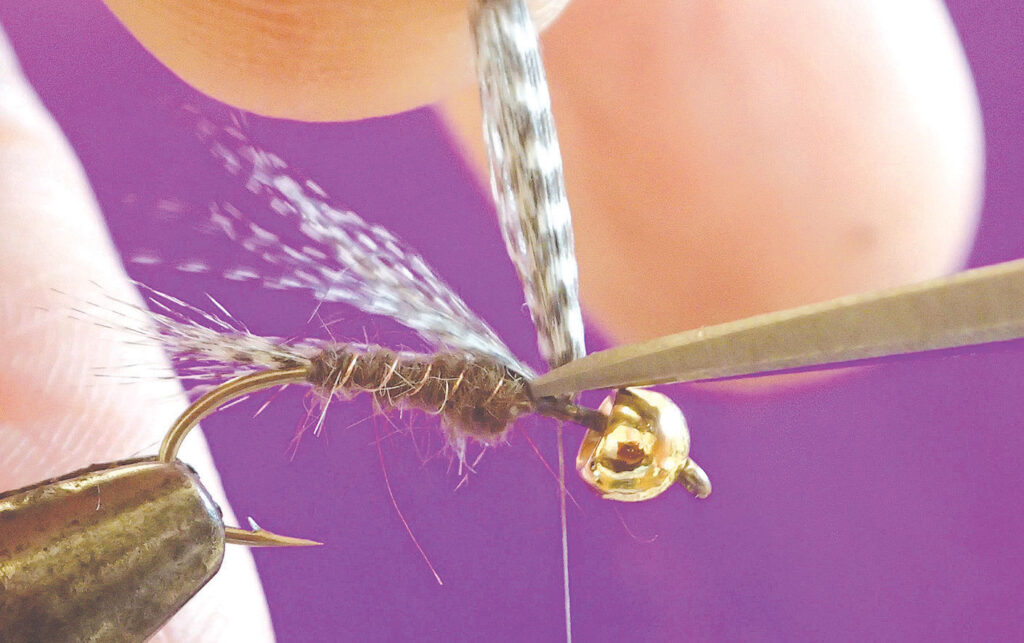
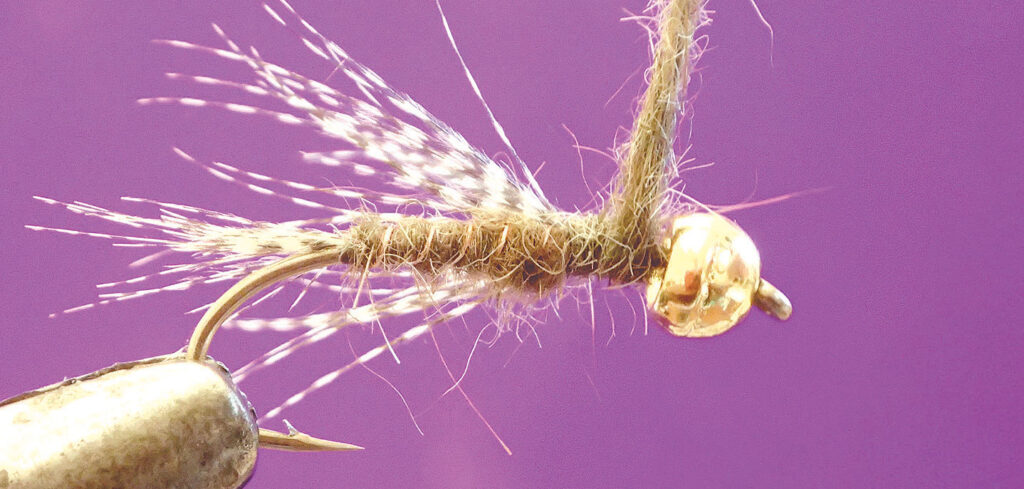
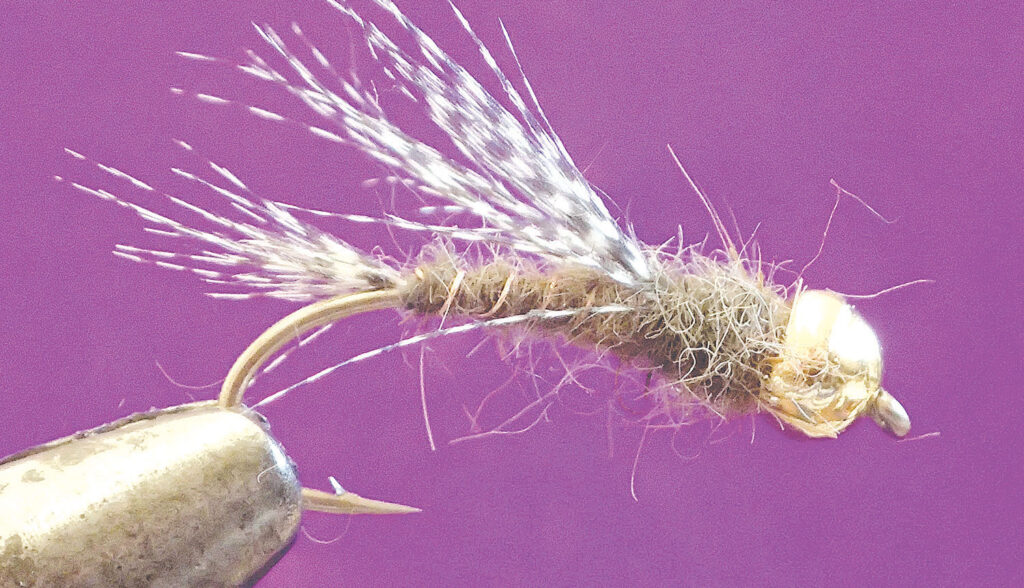
THE TYING STEPS FOR CHIP O’BRIEN’S VERSION OF THE BIRD’S NEST, PRESENTED IN SEQUENCE FROM TOP TO BOTTOM. NOTE THAT HE DOES NOT TAKE PARTICULAR CARE IN POSITIONING THE WING. CAL BIRD, CONVERSELY, USED A DISTRIBUTION WRAP THAT PLACED TEAL FIBERS AROUND THE HOOK, CREATING A BALANCED APPEARANCE.




